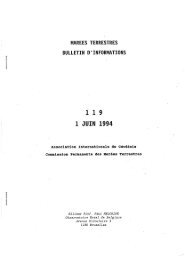marees terrestres bulletin d'informations - Université de la Polynésie ...
marees terrestres bulletin d'informations - Université de la Polynésie ...
marees terrestres bulletin d'informations - Université de la Polynésie ...
Create successful ePaper yourself
Turn your PDF publications into a flip-book with our unique Google optimized e-Paper software.
Figure 1<br />
Air <strong>de</strong>nsity distributions for Moxa station from 2007/07/01-2007/07/31<br />
(a) red line : ECMWF data , b<strong>la</strong>ck line : The US 1976 standard atmosphere<br />
(b) difference (air <strong>de</strong>nsity <strong>de</strong>rived from ECMWF data – US standard atmosphere)<br />
The air <strong>de</strong>nsity distribution is computed from 1 st of July, 2007 to 31 st of July,<br />
2007. In Fig.1b the difference between the air <strong>de</strong>nsity distribution based on<br />
eq.(2) and 3D ECMWF data is shown. Random variations occur up to a height of<br />
10 km with a <strong>de</strong>viation range of -0.04 to 0.02 kg/m 3 . The differences become<br />
<strong>la</strong>rger up to 0.04 kg/m 3 in a height of 11 km. Between 11 and 20 km distinct<br />
<strong>de</strong>viations are found. From the height of 20 km or more, the differences approach<br />
gradually 0. In Neumeyer et al. (2004), a test calcu<strong>la</strong>tion was carried out to<br />
estimate how much the changes in the air <strong>de</strong>nsity profiles affect the gravity<br />
reduction. Air <strong>de</strong>nsity profiles were changed within the range of 0.02 kg/m 3 up<br />
to 16km height and during 5 h. From this test calcu<strong>la</strong>tion, gravity changes of<br />
about 3 µGal were obtained.<br />
Thus, the <strong>de</strong>viation range of -0.04 to 0.02 kg/m 3 induces non-negligible gravity<br />
variations.<br />
2-3 Calcu<strong>la</strong>tion of the attraction term using 3D data<br />
The calcu<strong>la</strong>tion of the attraction term using 3D data is based on the<br />
gravitational potential of the air masses. Using spherical coordinates ( λ ,ϑ , r)<br />
with origin at the centre of the Earth and the Z-axis coinciding with the<br />
observation station, the gravitational potential of the air massΦ is given by



